Self-Care Plan: A Personal Journey of Weight Gain and Recovery
VerifiedAdded on 2022/09/16
|13
|3359
|19
Report
AI Summary
This report presents a student's self-care plan centered on weight gain, structured in two parts. Part A outlines the student's goal to gain 4 kilograms in a healthy manner, detailing strategies involving diet, exercise, and a support network comprising a gym instructor, nutritionist, and family. The plan addresses potential challenges like initial physical fatigue, food cravings, and maintaining the gained weight, providing strategies to overcome them. Part B offers a reflective discussion, comparing the student's experience to that of individuals with mental illness undergoing recovery. It emphasizes the importance of a holistic approach, including physical exercise, a strong support network, and therapeutic relationships. The report highlights challenges faced, such as muscle pain, dietary adjustments, and plateaus in weight gain, and details how the student adapted their plan, including incorporating exercise outside the home and working with the nutritionist to create a manageable diet. The report also underscores the importance of family support and therapeutic communication in the recovery process and highlights the unique challenges faced by individuals with mental illness in seeking and accepting help.
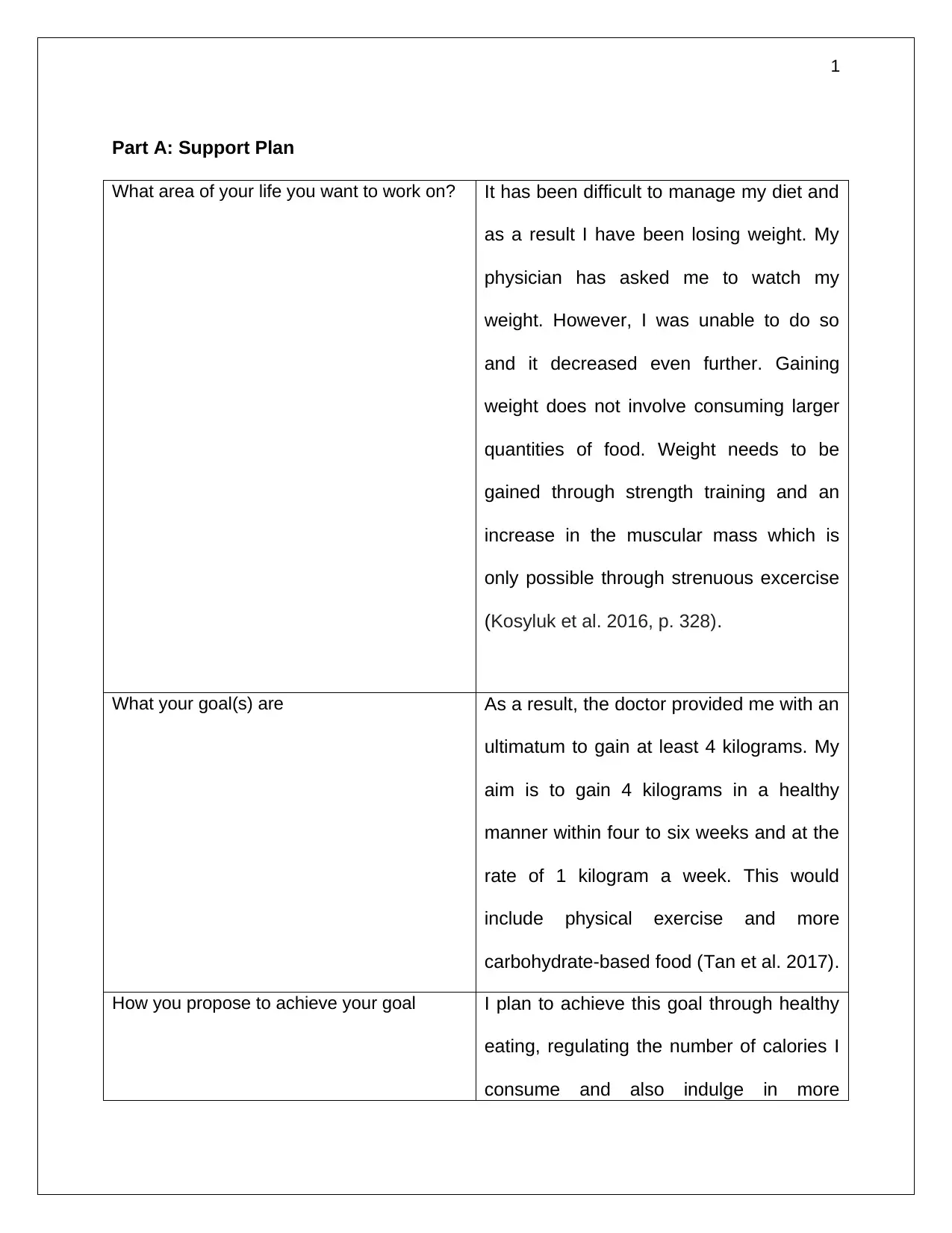
1
Part A: Support Plan
What area of your life you want to work on? It has been difficult to manage my diet and
as a result I have been losing weight. My
physician has asked me to watch my
weight. However, I was unable to do so
and it decreased even further. Gaining
weight does not involve consuming larger
quantities of food. Weight needs to be
gained through strength training and an
increase in the muscular mass which is
only possible through strenuous excercise
(Kosyluk et al. 2016, p. 328).
What your goal(s) are As a result, the doctor provided me with an
ultimatum to gain at least 4 kilograms. My
aim is to gain 4 kilograms in a healthy
manner within four to six weeks and at the
rate of 1 kilogram a week. This would
include physical exercise and more
carbohydrate-based food (Tan et al. 2017).
How you propose to achieve your goal I plan to achieve this goal through healthy
eating, regulating the number of calories I
consume and also indulge in more
Part A: Support Plan
What area of your life you want to work on? It has been difficult to manage my diet and
as a result I have been losing weight. My
physician has asked me to watch my
weight. However, I was unable to do so
and it decreased even further. Gaining
weight does not involve consuming larger
quantities of food. Weight needs to be
gained through strength training and an
increase in the muscular mass which is
only possible through strenuous excercise
(Kosyluk et al. 2016, p. 328).
What your goal(s) are As a result, the doctor provided me with an
ultimatum to gain at least 4 kilograms. My
aim is to gain 4 kilograms in a healthy
manner within four to six weeks and at the
rate of 1 kilogram a week. This would
include physical exercise and more
carbohydrate-based food (Tan et al. 2017).
How you propose to achieve your goal I plan to achieve this goal through healthy
eating, regulating the number of calories I
consume and also indulge in more
Paraphrase This Document
Need a fresh take? Get an instant paraphrase of this document with our AI Paraphraser
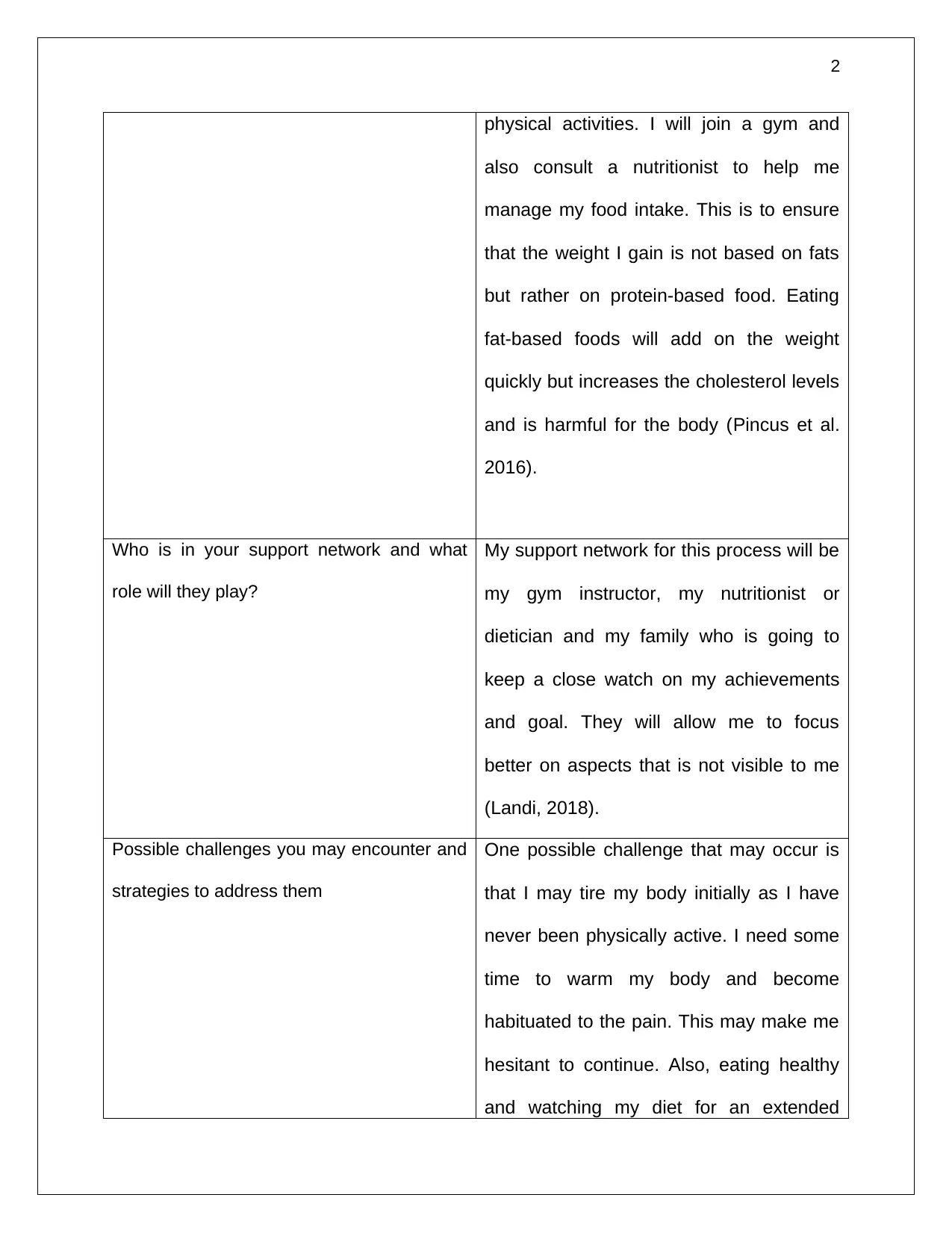
2
physical activities. I will join a gym and
also consult a nutritionist to help me
manage my food intake. This is to ensure
that the weight I gain is not based on fats
but rather on protein-based food. Eating
fat-based foods will add on the weight
quickly but increases the cholesterol levels
and is harmful for the body (Pincus et al.
2016).
Who is in your support network and what
role will they play?
My support network for this process will be
my gym instructor, my nutritionist or
dietician and my family who is going to
keep a close watch on my achievements
and goal. They will allow me to focus
better on aspects that is not visible to me
(Landi, 2018).
Possible challenges you may encounter and
strategies to address them
One possible challenge that may occur is
that I may tire my body initially as I have
never been physically active. I need some
time to warm my body and become
habituated to the pain. This may make me
hesitant to continue. Also, eating healthy
and watching my diet for an extended
physical activities. I will join a gym and
also consult a nutritionist to help me
manage my food intake. This is to ensure
that the weight I gain is not based on fats
but rather on protein-based food. Eating
fat-based foods will add on the weight
quickly but increases the cholesterol levels
and is harmful for the body (Pincus et al.
2016).
Who is in your support network and what
role will they play?
My support network for this process will be
my gym instructor, my nutritionist or
dietician and my family who is going to
keep a close watch on my achievements
and goal. They will allow me to focus
better on aspects that is not visible to me
(Landi, 2018).
Possible challenges you may encounter and
strategies to address them
One possible challenge that may occur is
that I may tire my body initially as I have
never been physically active. I need some
time to warm my body and become
habituated to the pain. This may make me
hesitant to continue. Also, eating healthy
and watching my diet for an extended
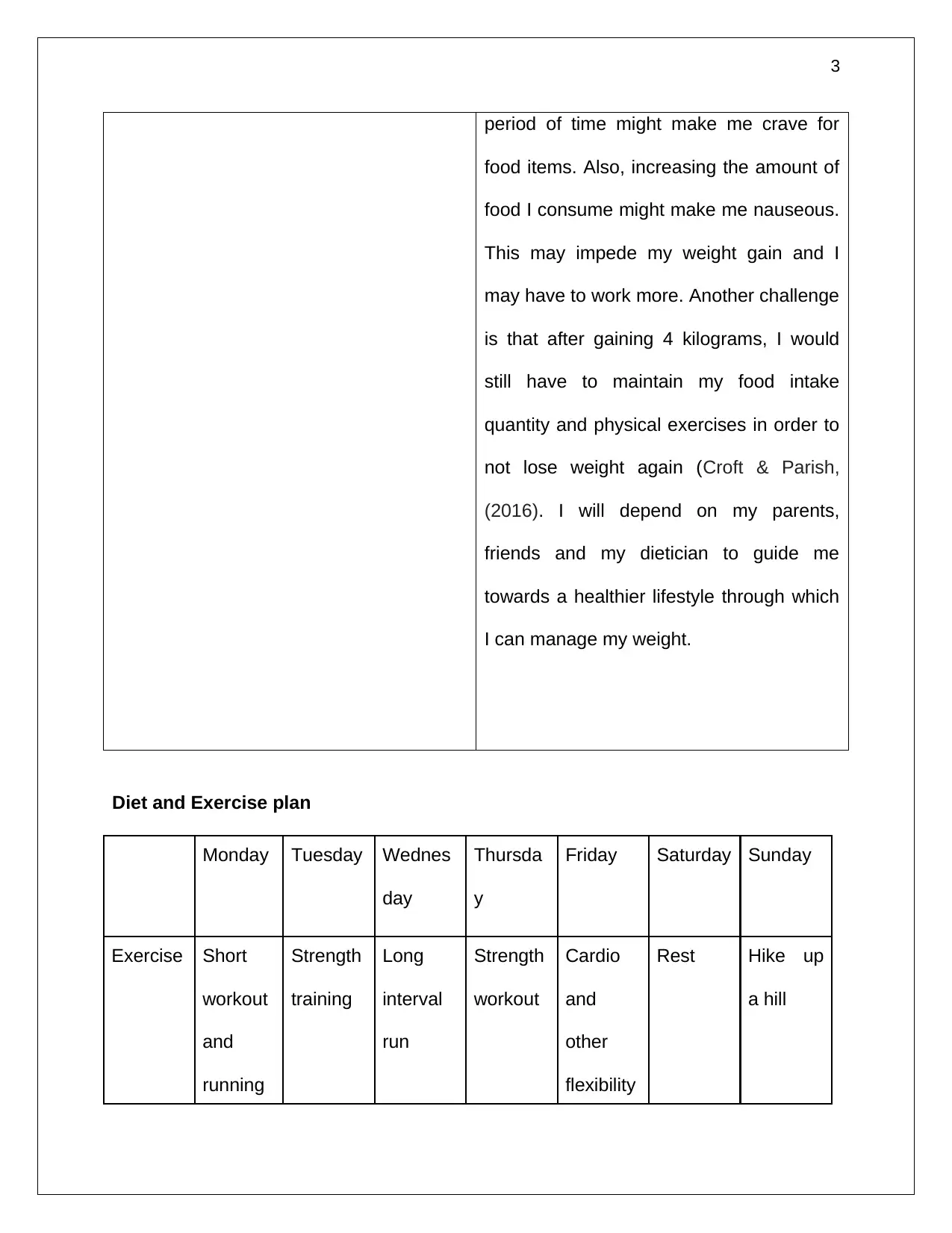
3
period of time might make me crave for
food items. Also, increasing the amount of
food I consume might make me nauseous.
This may impede my weight gain and I
may have to work more. Another challenge
is that after gaining 4 kilograms, I would
still have to maintain my food intake
quantity and physical exercises in order to
not lose weight again (Croft & Parish,
(2016). I will depend on my parents,
friends and my dietician to guide me
towards a healthier lifestyle through which
I can manage my weight.
Diet and Exercise plan
Monday Tuesday Wednes
day
Thursda
y
Friday Saturday Sunday
Exercise Short
workout
and
running
Strength
training
Long
interval
run
Strength
workout
Cardio
and
other
flexibility
Rest Hike up
a hill
period of time might make me crave for
food items. Also, increasing the amount of
food I consume might make me nauseous.
This may impede my weight gain and I
may have to work more. Another challenge
is that after gaining 4 kilograms, I would
still have to maintain my food intake
quantity and physical exercises in order to
not lose weight again (Croft & Parish,
(2016). I will depend on my parents,
friends and my dietician to guide me
towards a healthier lifestyle through which
I can manage my weight.
Diet and Exercise plan
Monday Tuesday Wednes
day
Thursda
y
Friday Saturday Sunday
Exercise Short
workout
and
running
Strength
training
Long
interval
run
Strength
workout
Cardio
and
other
flexibility
Rest Hike up
a hill
⊘ This is a preview!⊘
Do you want full access?
Subscribe today to unlock all pages.

Trusted by 1+ million students worldwide
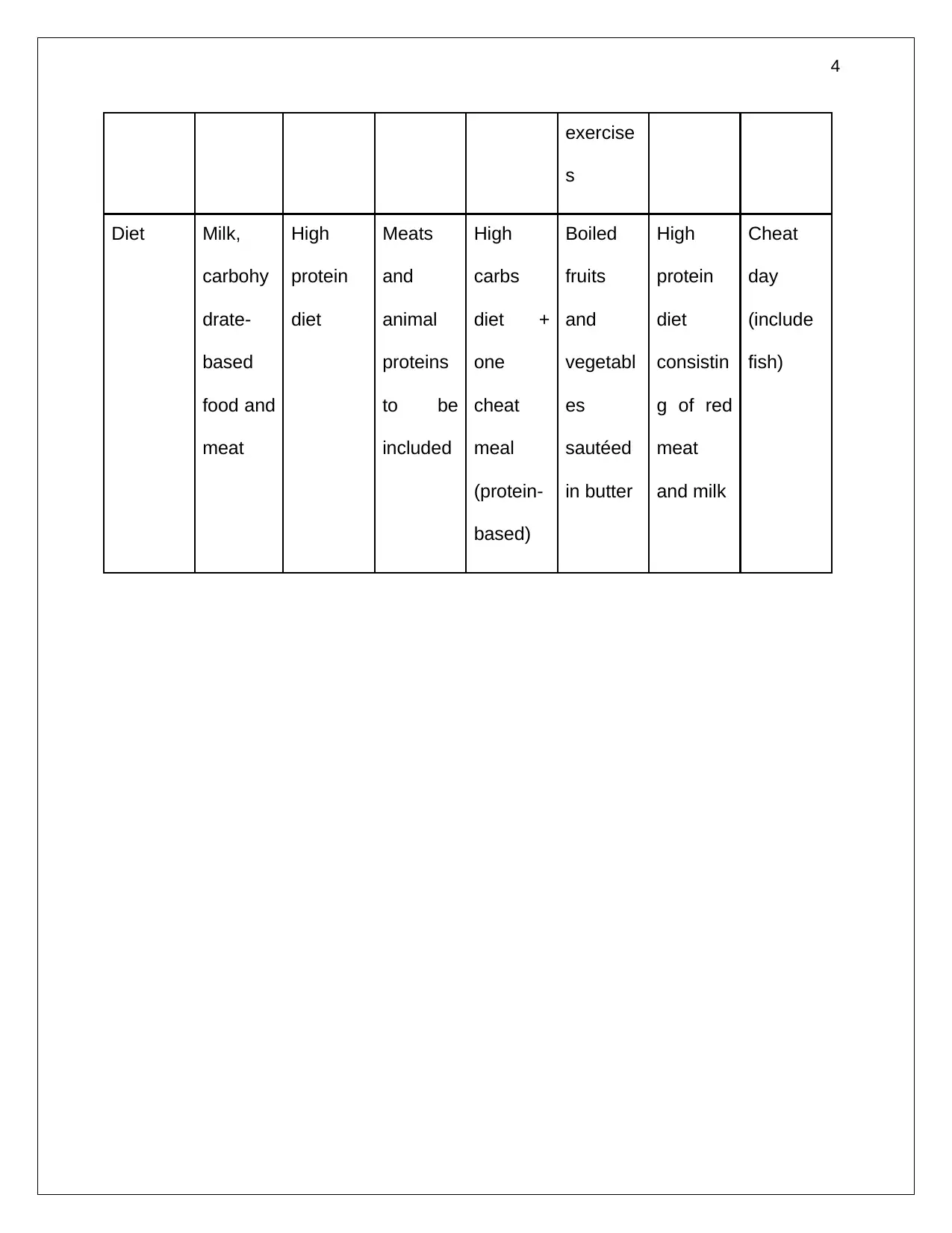
4
exercise
s
Diet Milk,
carbohy
drate-
based
food and
meat
High
protein
diet
Meats
and
animal
proteins
to be
included
High
carbs
diet +
one
cheat
meal
(protein-
based)
Boiled
fruits
and
vegetabl
es
sautéed
in butter
High
protein
diet
consistin
g of red
meat
and milk
Cheat
day
(include
fish)
exercise
s
Diet Milk,
carbohy
drate-
based
food and
meat
High
protein
diet
Meats
and
animal
proteins
to be
included
High
carbs
diet +
one
cheat
meal
(protein-
based)
Boiled
fruits
and
vegetabl
es
sautéed
in butter
High
protein
diet
consistin
g of red
meat
and milk
Cheat
day
(include
fish)
Paraphrase This Document
Need a fresh take? Get an instant paraphrase of this document with our AI Paraphraser
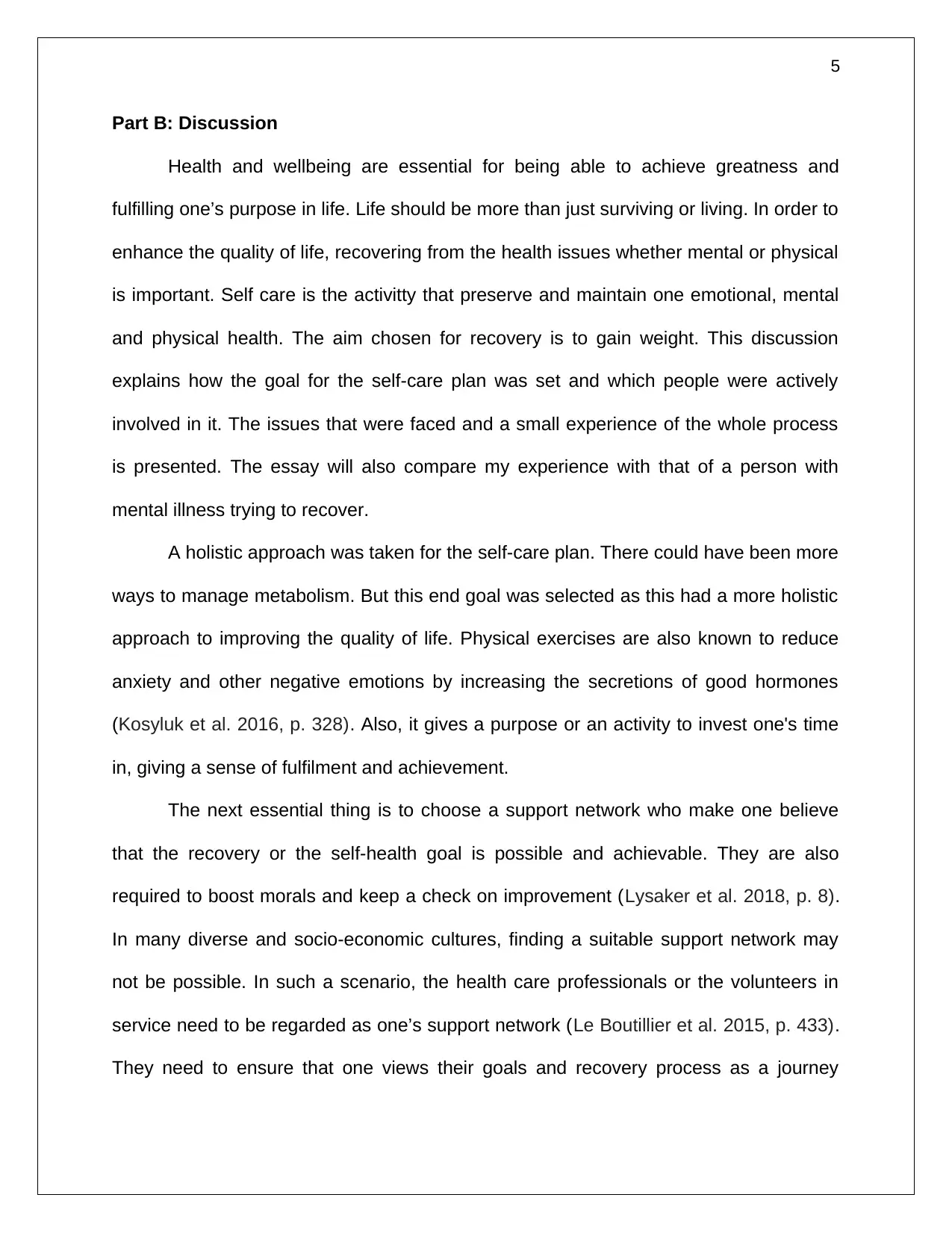
5
Part B: Discussion
Health and wellbeing are essential for being able to achieve greatness and
fulfilling one’s purpose in life. Life should be more than just surviving or living. In order to
enhance the quality of life, recovering from the health issues whether mental or physical
is important. Self care is the activitty that preserve and maintain one emotional, mental
and physical health. The aim chosen for recovery is to gain weight. This discussion
explains how the goal for the self-care plan was set and which people were actively
involved in it. The issues that were faced and a small experience of the whole process
is presented. The essay will also compare my experience with that of a person with
mental illness trying to recover.
A holistic approach was taken for the self-care plan. There could have been more
ways to manage metabolism. But this end goal was selected as this had a more holistic
approach to improving the quality of life. Physical exercises are also known to reduce
anxiety and other negative emotions by increasing the secretions of good hormones
(Kosyluk et al. 2016, p. 328). Also, it gives a purpose or an activity to invest one's time
in, giving a sense of fulfilment and achievement.
The next essential thing is to choose a support network who make one believe
that the recovery or the self-health goal is possible and achievable. They are also
required to boost morals and keep a check on improvement (Lysaker et al. 2018, p. 8).
In many diverse and socio-economic cultures, finding a suitable support network may
not be possible. In such a scenario, the health care professionals or the volunteers in
service need to be regarded as one’s support network (Le Boutillier et al. 2015, p. 433).
They need to ensure that one views their goals and recovery process as a journey
Part B: Discussion
Health and wellbeing are essential for being able to achieve greatness and
fulfilling one’s purpose in life. Life should be more than just surviving or living. In order to
enhance the quality of life, recovering from the health issues whether mental or physical
is important. Self care is the activitty that preserve and maintain one emotional, mental
and physical health. The aim chosen for recovery is to gain weight. This discussion
explains how the goal for the self-care plan was set and which people were actively
involved in it. The issues that were faced and a small experience of the whole process
is presented. The essay will also compare my experience with that of a person with
mental illness trying to recover.
A holistic approach was taken for the self-care plan. There could have been more
ways to manage metabolism. But this end goal was selected as this had a more holistic
approach to improving the quality of life. Physical exercises are also known to reduce
anxiety and other negative emotions by increasing the secretions of good hormones
(Kosyluk et al. 2016, p. 328). Also, it gives a purpose or an activity to invest one's time
in, giving a sense of fulfilment and achievement.
The next essential thing is to choose a support network who make one believe
that the recovery or the self-health goal is possible and achievable. They are also
required to boost morals and keep a check on improvement (Lysaker et al. 2018, p. 8).
In many diverse and socio-economic cultures, finding a suitable support network may
not be possible. In such a scenario, the health care professionals or the volunteers in
service need to be regarded as one’s support network (Le Boutillier et al. 2015, p. 433).
They need to ensure that one views their goals and recovery process as a journey
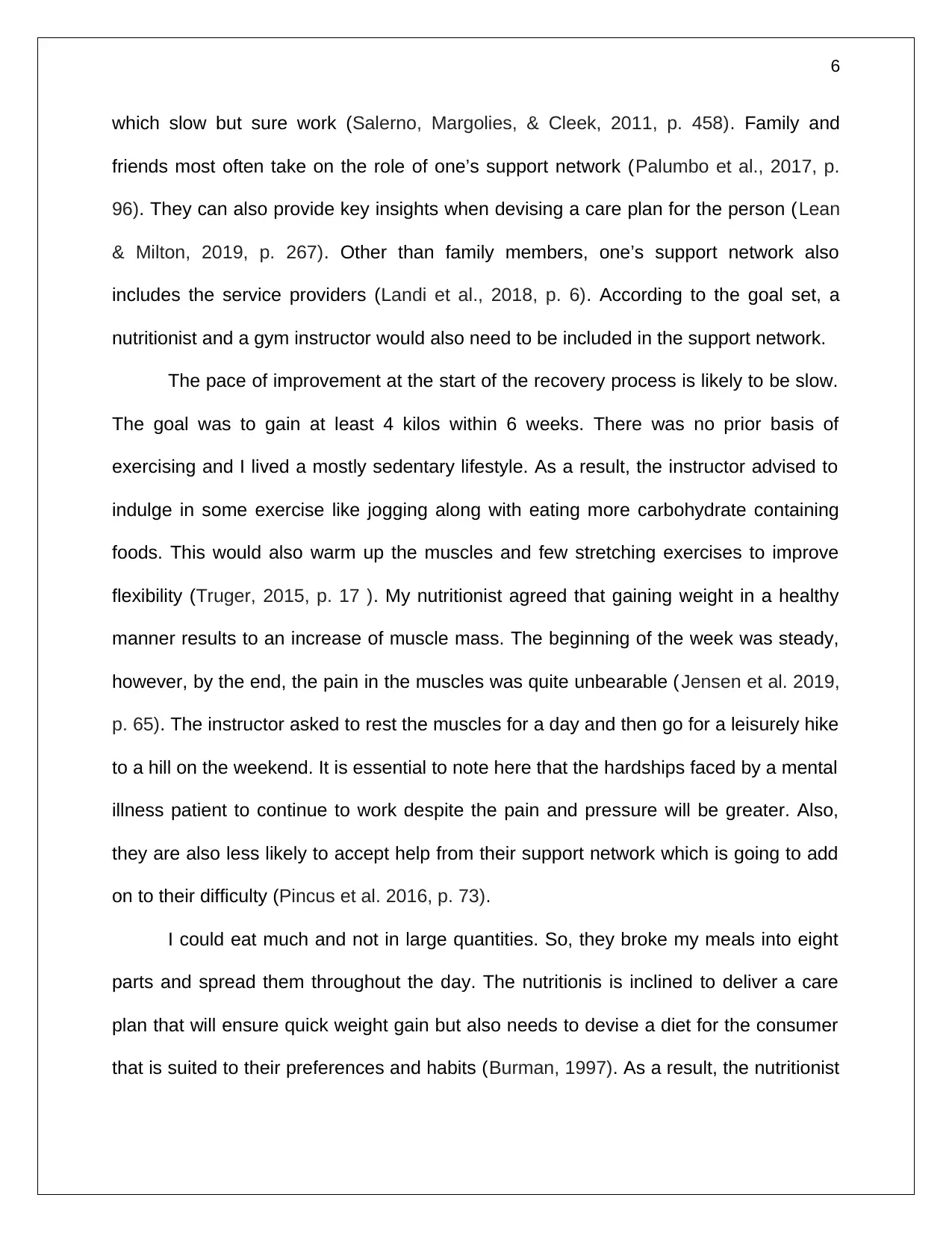
6
which slow but sure work (Salerno, Margolies, & Cleek, 2011, p. 458). Family and
friends most often take on the role of one’s support network (Palumbo et al., 2017, p.
96). They can also provide key insights when devising a care plan for the person (Lean
& Milton, 2019, p. 267). Other than family members, one’s support network also
includes the service providers (Landi et al., 2018, p. 6). According to the goal set, a
nutritionist and a gym instructor would also need to be included in the support network.
The pace of improvement at the start of the recovery process is likely to be slow.
The goal was to gain at least 4 kilos within 6 weeks. There was no prior basis of
exercising and I lived a mostly sedentary lifestyle. As a result, the instructor advised to
indulge in some exercise like jogging along with eating more carbohydrate containing
foods. This would also warm up the muscles and few stretching exercises to improve
flexibility (Truger, 2015, p. 17 ). My nutritionist agreed that gaining weight in a healthy
manner results to an increase of muscle mass. The beginning of the week was steady,
however, by the end, the pain in the muscles was quite unbearable (Jensen et al. 2019,
p. 65). The instructor asked to rest the muscles for a day and then go for a leisurely hike
to a hill on the weekend. It is essential to note here that the hardships faced by a mental
illness patient to continue to work despite the pain and pressure will be greater. Also,
they are also less likely to accept help from their support network which is going to add
on to their difficulty (Pincus et al. 2016, p. 73).
I could eat much and not in large quantities. So, they broke my meals into eight
parts and spread them throughout the day. The nutritionis is inclined to deliver a care
plan that will ensure quick weight gain but also needs to devise a diet for the consumer
that is suited to their preferences and habits (Burman, 1997). As a result, the nutritionist
which slow but sure work (Salerno, Margolies, & Cleek, 2011, p. 458). Family and
friends most often take on the role of one’s support network (Palumbo et al., 2017, p.
96). They can also provide key insights when devising a care plan for the person (Lean
& Milton, 2019, p. 267). Other than family members, one’s support network also
includes the service providers (Landi et al., 2018, p. 6). According to the goal set, a
nutritionist and a gym instructor would also need to be included in the support network.
The pace of improvement at the start of the recovery process is likely to be slow.
The goal was to gain at least 4 kilos within 6 weeks. There was no prior basis of
exercising and I lived a mostly sedentary lifestyle. As a result, the instructor advised to
indulge in some exercise like jogging along with eating more carbohydrate containing
foods. This would also warm up the muscles and few stretching exercises to improve
flexibility (Truger, 2015, p. 17 ). My nutritionist agreed that gaining weight in a healthy
manner results to an increase of muscle mass. The beginning of the week was steady,
however, by the end, the pain in the muscles was quite unbearable (Jensen et al. 2019,
p. 65). The instructor asked to rest the muscles for a day and then go for a leisurely hike
to a hill on the weekend. It is essential to note here that the hardships faced by a mental
illness patient to continue to work despite the pain and pressure will be greater. Also,
they are also less likely to accept help from their support network which is going to add
on to their difficulty (Pincus et al. 2016, p. 73).
I could eat much and not in large quantities. So, they broke my meals into eight
parts and spread them throughout the day. The nutritionis is inclined to deliver a care
plan that will ensure quick weight gain but also needs to devise a diet for the consumer
that is suited to their preferences and habits (Burman, 1997). As a result, the nutritionist
⊘ This is a preview!⊘
Do you want full access?
Subscribe today to unlock all pages.

Trusted by 1+ million students worldwide
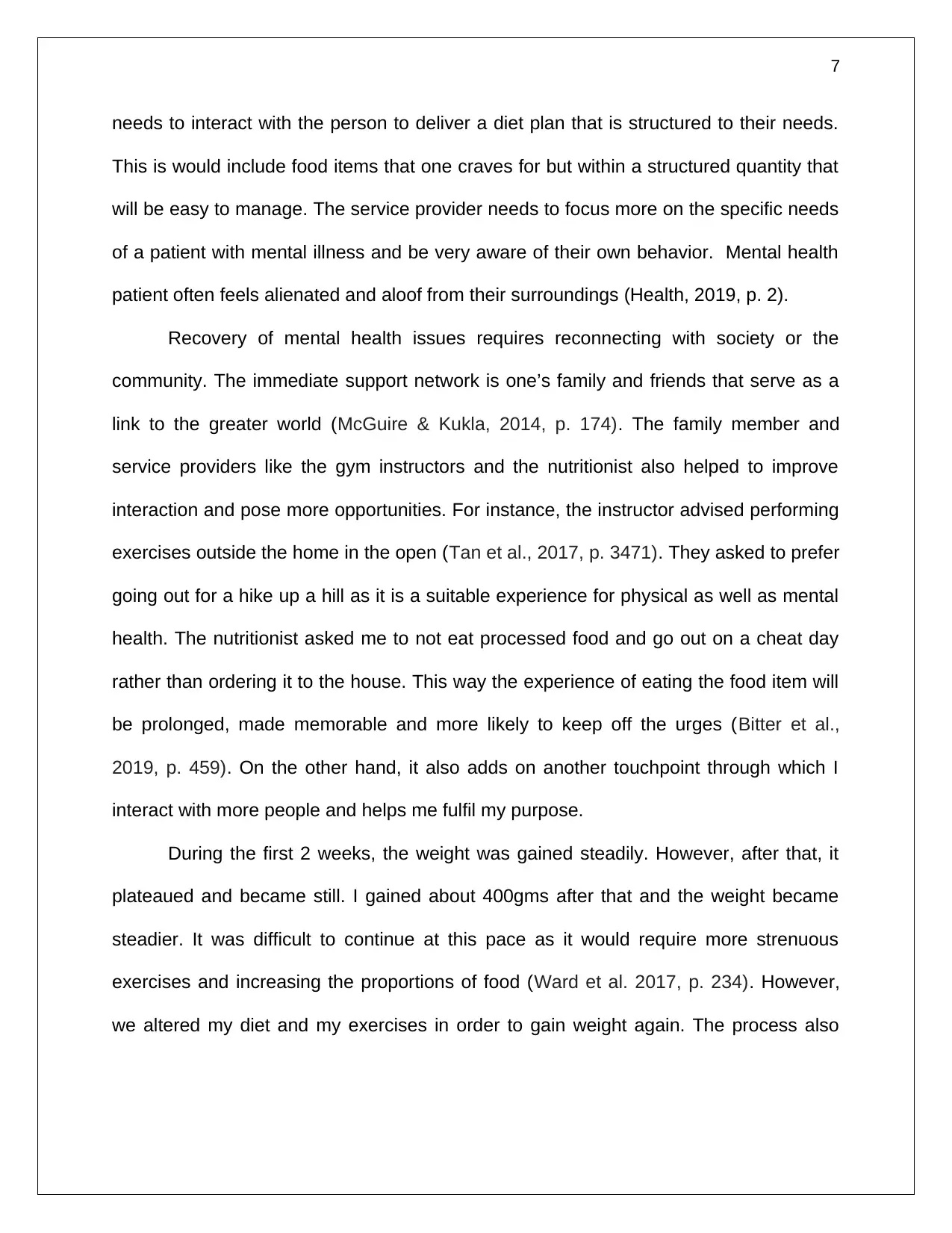
7
needs to interact with the person to deliver a diet plan that is structured to their needs.
This is would include food items that one craves for but within a structured quantity that
will be easy to manage. The service provider needs to focus more on the specific needs
of a patient with mental illness and be very aware of their own behavior. Mental health
patient often feels alienated and aloof from their surroundings (Health, 2019, p. 2).
Recovery of mental health issues requires reconnecting with society or the
community. The immediate support network is one’s family and friends that serve as a
link to the greater world (McGuire & Kukla, 2014, p. 174). The family member and
service providers like the gym instructors and the nutritionist also helped to improve
interaction and pose more opportunities. For instance, the instructor advised performing
exercises outside the home in the open (Tan et al., 2017, p. 3471). They asked to prefer
going out for a hike up a hill as it is a suitable experience for physical as well as mental
health. The nutritionist asked me to not eat processed food and go out on a cheat day
rather than ordering it to the house. This way the experience of eating the food item will
be prolonged, made memorable and more likely to keep off the urges (Bitter et al.,
2019, p. 459). On the other hand, it also adds on another touchpoint through which I
interact with more people and helps me fulfil my purpose.
During the first 2 weeks, the weight was gained steadily. However, after that, it
plateaued and became still. I gained about 400gms after that and the weight became
steadier. It was difficult to continue at this pace as it would require more strenuous
exercises and increasing the proportions of food (Ward et al. 2017, p. 234). However,
we altered my diet and my exercises in order to gain weight again. The process also
needs to interact with the person to deliver a diet plan that is structured to their needs.
This is would include food items that one craves for but within a structured quantity that
will be easy to manage. The service provider needs to focus more on the specific needs
of a patient with mental illness and be very aware of their own behavior. Mental health
patient often feels alienated and aloof from their surroundings (Health, 2019, p. 2).
Recovery of mental health issues requires reconnecting with society or the
community. The immediate support network is one’s family and friends that serve as a
link to the greater world (McGuire & Kukla, 2014, p. 174). The family member and
service providers like the gym instructors and the nutritionist also helped to improve
interaction and pose more opportunities. For instance, the instructor advised performing
exercises outside the home in the open (Tan et al., 2017, p. 3471). They asked to prefer
going out for a hike up a hill as it is a suitable experience for physical as well as mental
health. The nutritionist asked me to not eat processed food and go out on a cheat day
rather than ordering it to the house. This way the experience of eating the food item will
be prolonged, made memorable and more likely to keep off the urges (Bitter et al.,
2019, p. 459). On the other hand, it also adds on another touchpoint through which I
interact with more people and helps me fulfil my purpose.
During the first 2 weeks, the weight was gained steadily. However, after that, it
plateaued and became still. I gained about 400gms after that and the weight became
steadier. It was difficult to continue at this pace as it would require more strenuous
exercises and increasing the proportions of food (Ward et al. 2017, p. 234). However,
we altered my diet and my exercises in order to gain weight again. The process also
Paraphrase This Document
Need a fresh take? Get an instant paraphrase of this document with our AI Paraphraser
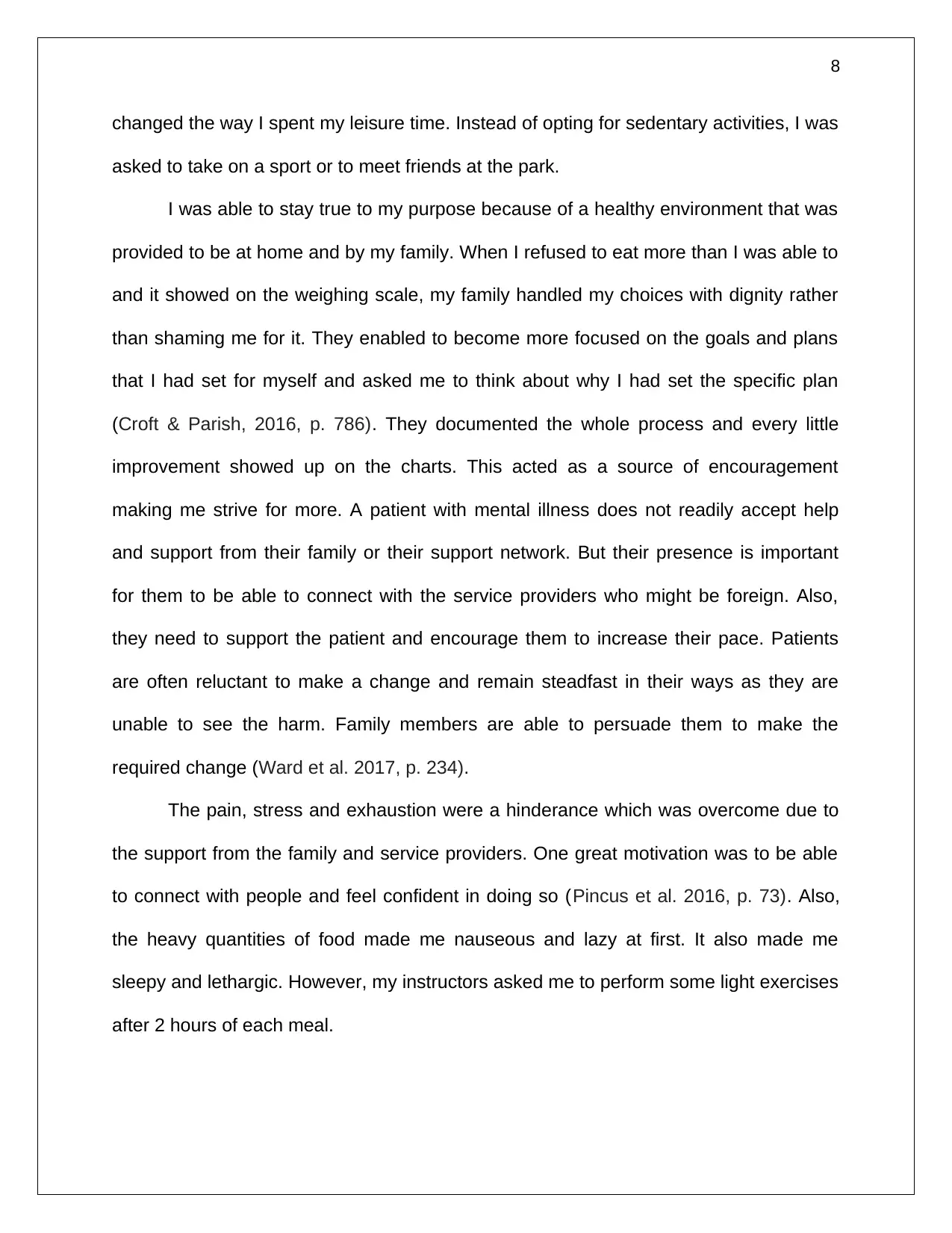
8
changed the way I spent my leisure time. Instead of opting for sedentary activities, I was
asked to take on a sport or to meet friends at the park.
I was able to stay true to my purpose because of a healthy environment that was
provided to be at home and by my family. When I refused to eat more than I was able to
and it showed on the weighing scale, my family handled my choices with dignity rather
than shaming me for it. They enabled to become more focused on the goals and plans
that I had set for myself and asked me to think about why I had set the specific plan
(Croft & Parish, 2016, p. 786). They documented the whole process and every little
improvement showed up on the charts. This acted as a source of encouragement
making me strive for more. A patient with mental illness does not readily accept help
and support from their family or their support network. But their presence is important
for them to be able to connect with the service providers who might be foreign. Also,
they need to support the patient and encourage them to increase their pace. Patients
are often reluctant to make a change and remain steadfast in their ways as they are
unable to see the harm. Family members are able to persuade them to make the
required change (Ward et al. 2017, p. 234).
The pain, stress and exhaustion were a hinderance which was overcome due to
the support from the family and service providers. One great motivation was to be able
to connect with people and feel confident in doing so (Pincus et al. 2016, p. 73). Also,
the heavy quantities of food made me nauseous and lazy at first. It also made me
sleepy and lethargic. However, my instructors asked me to perform some light exercises
after 2 hours of each meal.
changed the way I spent my leisure time. Instead of opting for sedentary activities, I was
asked to take on a sport or to meet friends at the park.
I was able to stay true to my purpose because of a healthy environment that was
provided to be at home and by my family. When I refused to eat more than I was able to
and it showed on the weighing scale, my family handled my choices with dignity rather
than shaming me for it. They enabled to become more focused on the goals and plans
that I had set for myself and asked me to think about why I had set the specific plan
(Croft & Parish, 2016, p. 786). They documented the whole process and every little
improvement showed up on the charts. This acted as a source of encouragement
making me strive for more. A patient with mental illness does not readily accept help
and support from their family or their support network. But their presence is important
for them to be able to connect with the service providers who might be foreign. Also,
they need to support the patient and encourage them to increase their pace. Patients
are often reluctant to make a change and remain steadfast in their ways as they are
unable to see the harm. Family members are able to persuade them to make the
required change (Ward et al. 2017, p. 234).
The pain, stress and exhaustion were a hinderance which was overcome due to
the support from the family and service providers. One great motivation was to be able
to connect with people and feel confident in doing so (Pincus et al. 2016, p. 73). Also,
the heavy quantities of food made me nauseous and lazy at first. It also made me
sleepy and lethargic. However, my instructors asked me to perform some light exercises
after 2 hours of each meal.
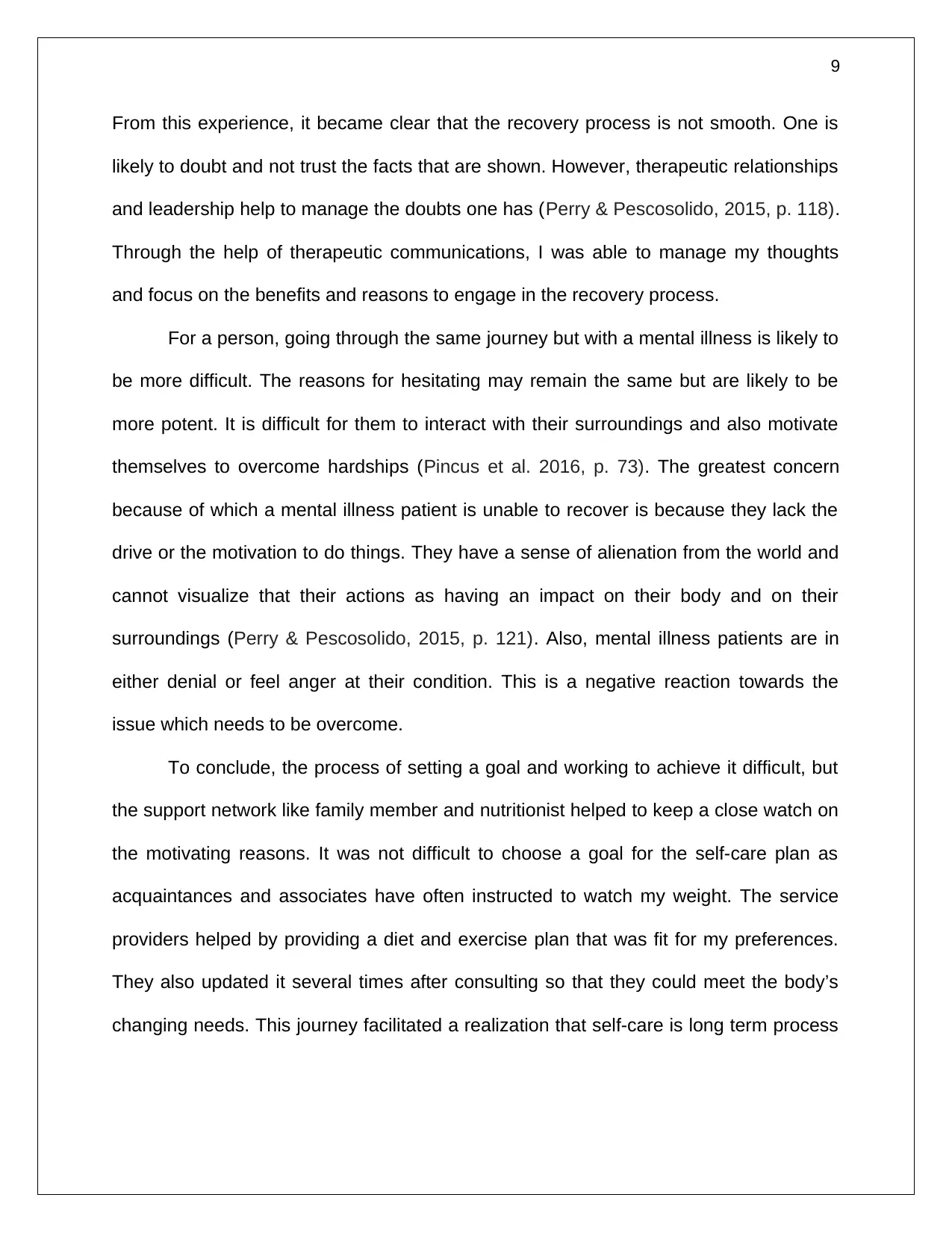
9
From this experience, it became clear that the recovery process is not smooth. One is
likely to doubt and not trust the facts that are shown. However, therapeutic relationships
and leadership help to manage the doubts one has (Perry & Pescosolido, 2015, p. 118).
Through the help of therapeutic communications, I was able to manage my thoughts
and focus on the benefits and reasons to engage in the recovery process.
For a person, going through the same journey but with a mental illness is likely to
be more difficult. The reasons for hesitating may remain the same but are likely to be
more potent. It is difficult for them to interact with their surroundings and also motivate
themselves to overcome hardships (Pincus et al. 2016, p. 73). The greatest concern
because of which a mental illness patient is unable to recover is because they lack the
drive or the motivation to do things. They have a sense of alienation from the world and
cannot visualize that their actions as having an impact on their body and on their
surroundings (Perry & Pescosolido, 2015, p. 121). Also, mental illness patients are in
either denial or feel anger at their condition. This is a negative reaction towards the
issue which needs to be overcome.
To conclude, the process of setting a goal and working to achieve it difficult, but
the support network like family member and nutritionist helped to keep a close watch on
the motivating reasons. It was not difficult to choose a goal for the self-care plan as
acquaintances and associates have often instructed to watch my weight. The service
providers helped by providing a diet and exercise plan that was fit for my preferences.
They also updated it several times after consulting so that they could meet the body’s
changing needs. This journey facilitated a realization that self-care is long term process
From this experience, it became clear that the recovery process is not smooth. One is
likely to doubt and not trust the facts that are shown. However, therapeutic relationships
and leadership help to manage the doubts one has (Perry & Pescosolido, 2015, p. 118).
Through the help of therapeutic communications, I was able to manage my thoughts
and focus on the benefits and reasons to engage in the recovery process.
For a person, going through the same journey but with a mental illness is likely to
be more difficult. The reasons for hesitating may remain the same but are likely to be
more potent. It is difficult for them to interact with their surroundings and also motivate
themselves to overcome hardships (Pincus et al. 2016, p. 73). The greatest concern
because of which a mental illness patient is unable to recover is because they lack the
drive or the motivation to do things. They have a sense of alienation from the world and
cannot visualize that their actions as having an impact on their body and on their
surroundings (Perry & Pescosolido, 2015, p. 121). Also, mental illness patients are in
either denial or feel anger at their condition. This is a negative reaction towards the
issue which needs to be overcome.
To conclude, the process of setting a goal and working to achieve it difficult, but
the support network like family member and nutritionist helped to keep a close watch on
the motivating reasons. It was not difficult to choose a goal for the self-care plan as
acquaintances and associates have often instructed to watch my weight. The service
providers helped by providing a diet and exercise plan that was fit for my preferences.
They also updated it several times after consulting so that they could meet the body’s
changing needs. This journey facilitated a realization that self-care is long term process
⊘ This is a preview!⊘
Do you want full access?
Subscribe today to unlock all pages.

Trusted by 1+ million students worldwide
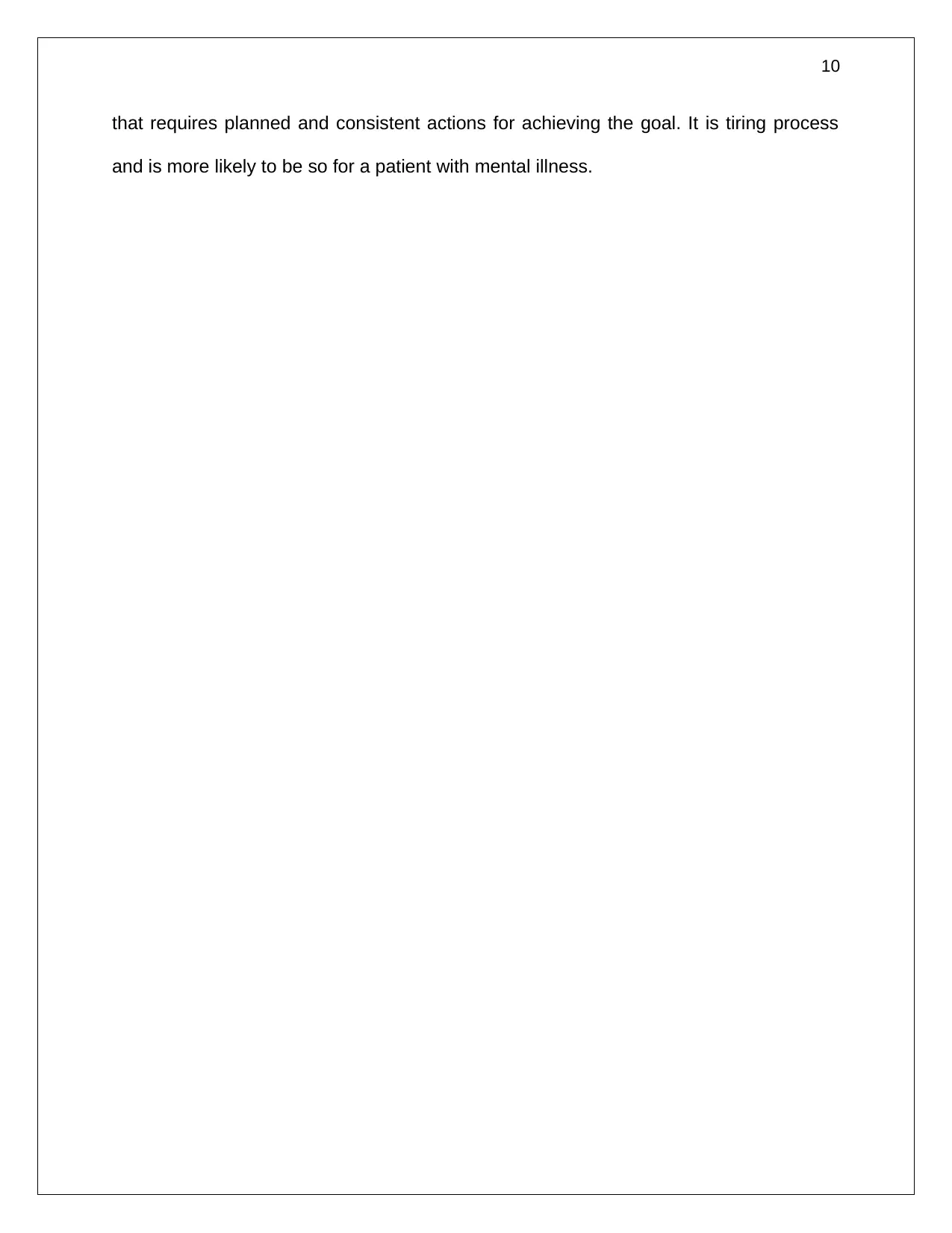
10
that requires planned and consistent actions for achieving the goal. It is tiring process
and is more likely to be so for a patient with mental illness.
that requires planned and consistent actions for achieving the goal. It is tiring process
and is more likely to be so for a patient with mental illness.
Paraphrase This Document
Need a fresh take? Get an instant paraphrase of this document with our AI Paraphraser
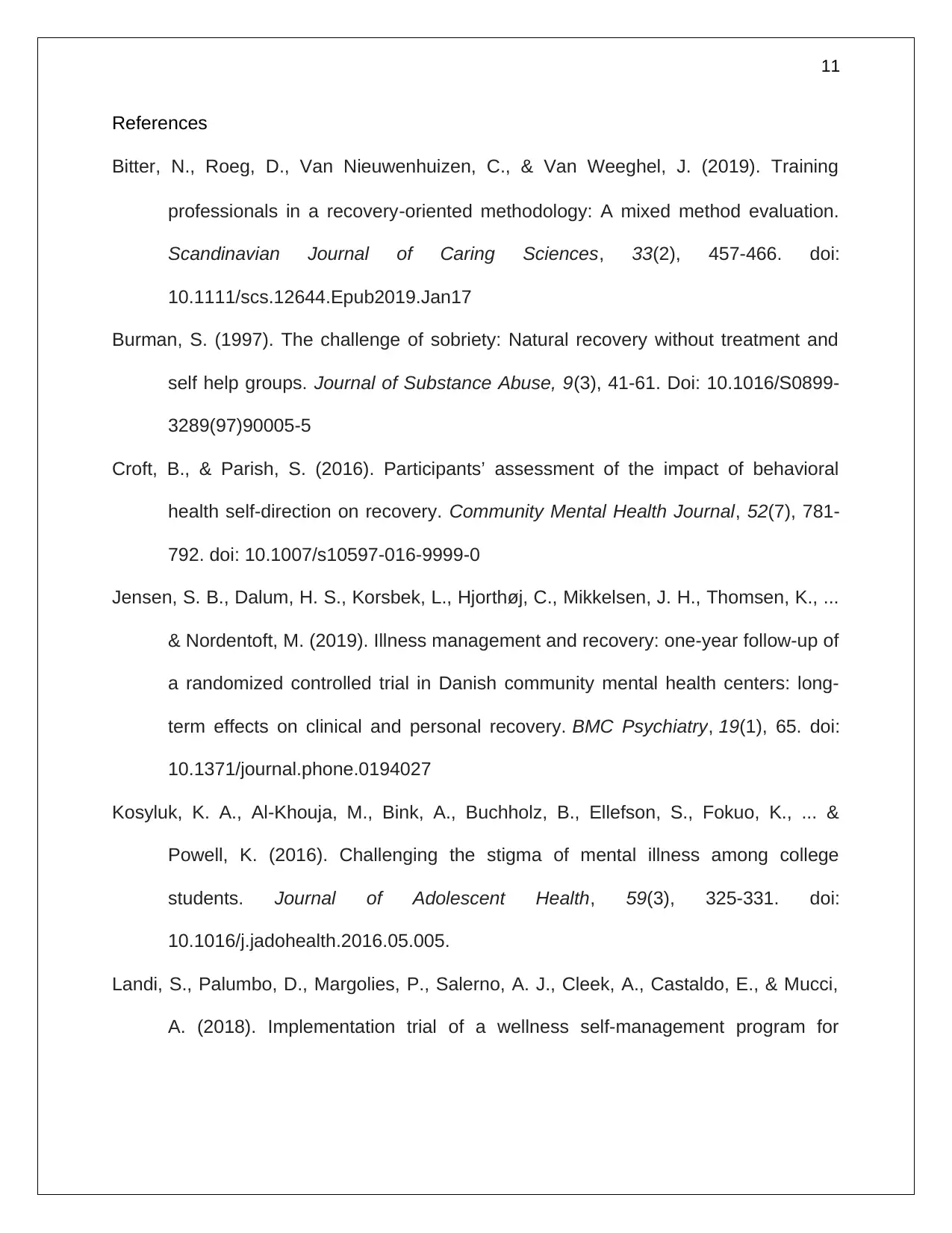
11
References
Bitter, N., Roeg, D., Van Nieuwenhuizen, C., & Van Weeghel, J. (2019). Training
professionals in a recovery‐oriented methodology: A mixed method evaluation.
Scandinavian Journal of Caring Sciences, 33(2), 457-466. doi:
10.1111/scs.12644.Epub2019.Jan17
Burman, S. (1997). The challenge of sobriety: Natural recovery without treatment and
self help groups. Journal of Substance Abuse, 9(3), 41-61. Doi: 10.1016/S0899-
3289(97)90005-5
Croft, B., & Parish, S. (2016). Participants’ assessment of the impact of behavioral
health self-direction on recovery. Community Mental Health Journal, 52(7), 781-
792. doi: 10.1007/s10597-016-9999-0
Jensen, S. B., Dalum, H. S., Korsbek, L., Hjorthøj, C., Mikkelsen, J. H., Thomsen, K., ...
& Nordentoft, M. (2019). Illness management and recovery: one-year follow-up of
a randomized controlled trial in Danish community mental health centers: long-
term effects on clinical and personal recovery. BMC Psychiatry, 19(1), 65. doi:
10.1371/journal.phone.0194027
Kosyluk, K. A., Al-Khouja, M., Bink, A., Buchholz, B., Ellefson, S., Fokuo, K., ... &
Powell, K. (2016). Challenging the stigma of mental illness among college
students. Journal of Adolescent Health, 59(3), 325-331. doi:
10.1016/j.jadohealth.2016.05.005.
Landi, S., Palumbo, D., Margolies, P., Salerno, A. J., Cleek, A., Castaldo, E., & Mucci,
A. (2018). Implementation trial of a wellness self-management program for
References
Bitter, N., Roeg, D., Van Nieuwenhuizen, C., & Van Weeghel, J. (2019). Training
professionals in a recovery‐oriented methodology: A mixed method evaluation.
Scandinavian Journal of Caring Sciences, 33(2), 457-466. doi:
10.1111/scs.12644.Epub2019.Jan17
Burman, S. (1997). The challenge of sobriety: Natural recovery without treatment and
self help groups. Journal of Substance Abuse, 9(3), 41-61. Doi: 10.1016/S0899-
3289(97)90005-5
Croft, B., & Parish, S. (2016). Participants’ assessment of the impact of behavioral
health self-direction on recovery. Community Mental Health Journal, 52(7), 781-
792. doi: 10.1007/s10597-016-9999-0
Jensen, S. B., Dalum, H. S., Korsbek, L., Hjorthøj, C., Mikkelsen, J. H., Thomsen, K., ...
& Nordentoft, M. (2019). Illness management and recovery: one-year follow-up of
a randomized controlled trial in Danish community mental health centers: long-
term effects on clinical and personal recovery. BMC Psychiatry, 19(1), 65. doi:
10.1371/journal.phone.0194027
Kosyluk, K. A., Al-Khouja, M., Bink, A., Buchholz, B., Ellefson, S., Fokuo, K., ... &
Powell, K. (2016). Challenging the stigma of mental illness among college
students. Journal of Adolescent Health, 59(3), 325-331. doi:
10.1016/j.jadohealth.2016.05.005.
Landi, S., Palumbo, D., Margolies, P., Salerno, A. J., Cleek, A., Castaldo, E., & Mucci,
A. (2018). Implementation trial of a wellness self-management program for
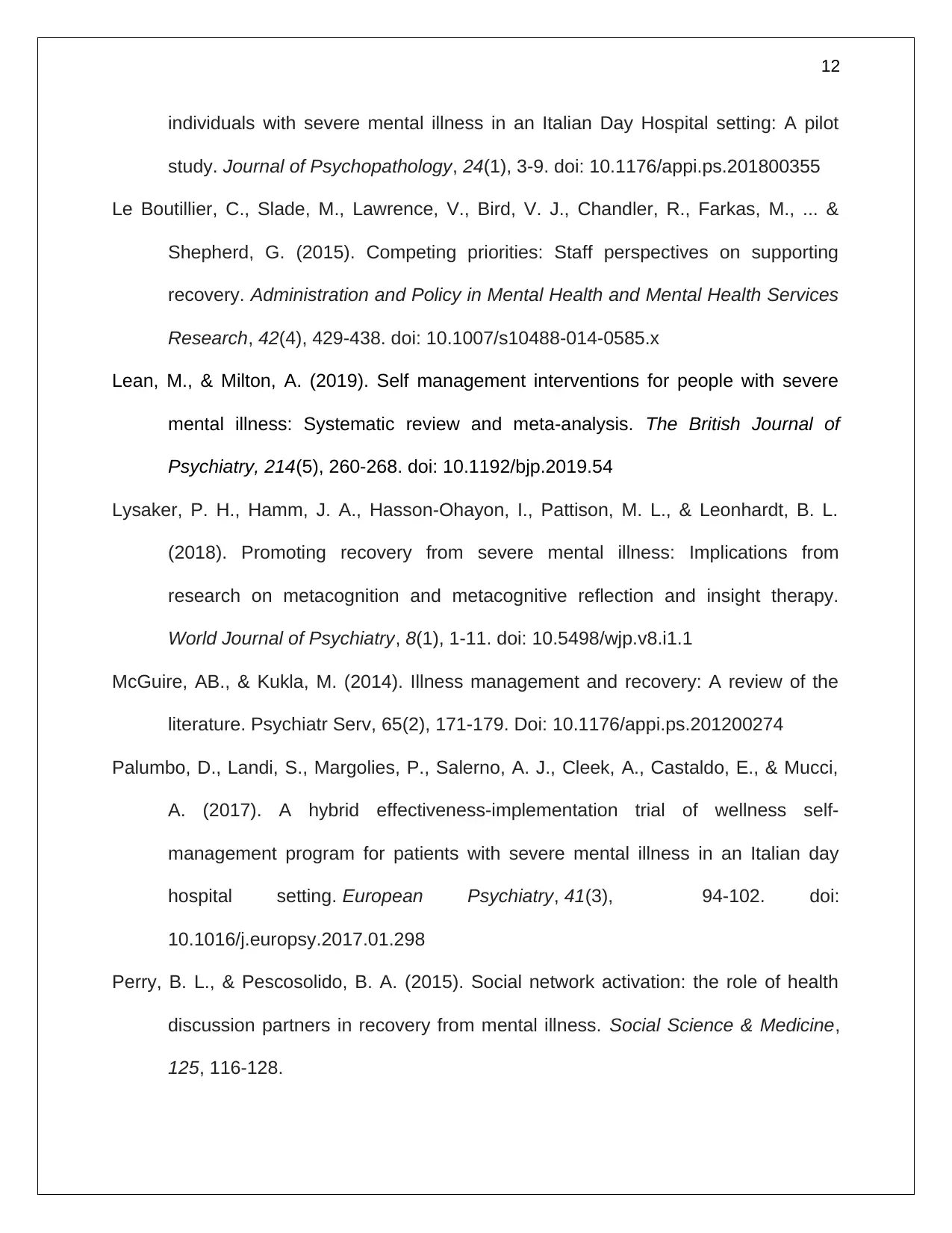
12
individuals with severe mental illness in an Italian Day Hospital setting: A pilot
study. Journal of Psychopathology, 24(1), 3-9. doi: 10.1176/appi.ps.201800355
Le Boutillier, C., Slade, M., Lawrence, V., Bird, V. J., Chandler, R., Farkas, M., ... &
Shepherd, G. (2015). Competing priorities: Staff perspectives on supporting
recovery. Administration and Policy in Mental Health and Mental Health Services
Research, 42(4), 429-438. doi: 10.1007/s10488-014-0585.x
Lean, M., & Milton, A. (2019). Self management interventions for people with severe
mental illness: Systematic review and meta-analysis. The British Journal of
Psychiatry, 214(5), 260-268. doi: 10.1192/bjp.2019.54
Lysaker, P. H., Hamm, J. A., Hasson-Ohayon, I., Pattison, M. L., & Leonhardt, B. L.
(2018). Promoting recovery from severe mental illness: Implications from
research on metacognition and metacognitive reflection and insight therapy.
World Journal of Psychiatry, 8(1), 1-11. doi: 10.5498/wjp.v8.i1.1
McGuire, AB., & Kukla, M. (2014). Illness management and recovery: A review of the
literature. Psychiatr Serv, 65(2), 171-179. Doi: 10.1176/appi.ps.201200274
Palumbo, D., Landi, S., Margolies, P., Salerno, A. J., Cleek, A., Castaldo, E., & Mucci,
A. (2017). A hybrid effectiveness-implementation trial of wellness self-
management program for patients with severe mental illness in an Italian day
hospital setting. European Psychiatry, 41(3), 94-102. doi:
10.1016/j.europsy.2017.01.298
Perry, B. L., & Pescosolido, B. A. (2015). Social network activation: the role of health
discussion partners in recovery from mental illness. Social Science & Medicine,
125, 116-128.
individuals with severe mental illness in an Italian Day Hospital setting: A pilot
study. Journal of Psychopathology, 24(1), 3-9. doi: 10.1176/appi.ps.201800355
Le Boutillier, C., Slade, M., Lawrence, V., Bird, V. J., Chandler, R., Farkas, M., ... &
Shepherd, G. (2015). Competing priorities: Staff perspectives on supporting
recovery. Administration and Policy in Mental Health and Mental Health Services
Research, 42(4), 429-438. doi: 10.1007/s10488-014-0585.x
Lean, M., & Milton, A. (2019). Self management interventions for people with severe
mental illness: Systematic review and meta-analysis. The British Journal of
Psychiatry, 214(5), 260-268. doi: 10.1192/bjp.2019.54
Lysaker, P. H., Hamm, J. A., Hasson-Ohayon, I., Pattison, M. L., & Leonhardt, B. L.
(2018). Promoting recovery from severe mental illness: Implications from
research on metacognition and metacognitive reflection and insight therapy.
World Journal of Psychiatry, 8(1), 1-11. doi: 10.5498/wjp.v8.i1.1
McGuire, AB., & Kukla, M. (2014). Illness management and recovery: A review of the
literature. Psychiatr Serv, 65(2), 171-179. Doi: 10.1176/appi.ps.201200274
Palumbo, D., Landi, S., Margolies, P., Salerno, A. J., Cleek, A., Castaldo, E., & Mucci,
A. (2017). A hybrid effectiveness-implementation trial of wellness self-
management program for patients with severe mental illness in an Italian day
hospital setting. European Psychiatry, 41(3), 94-102. doi:
10.1016/j.europsy.2017.01.298
Perry, B. L., & Pescosolido, B. A. (2015). Social network activation: the role of health
discussion partners in recovery from mental illness. Social Science & Medicine,
125, 116-128.
⊘ This is a preview!⊘
Do you want full access?
Subscribe today to unlock all pages.

Trusted by 1+ million students worldwide
1 out of 13
Related Documents
Your All-in-One AI-Powered Toolkit for Academic Success.
+13062052269
info@desklib.com
Available 24*7 on WhatsApp / Email
![[object Object]](/_next/static/media/star-bottom.7253800d.svg)
Unlock your academic potential
Copyright © 2020–2025 A2Z Services. All Rights Reserved. Developed and managed by ZUCOL.





